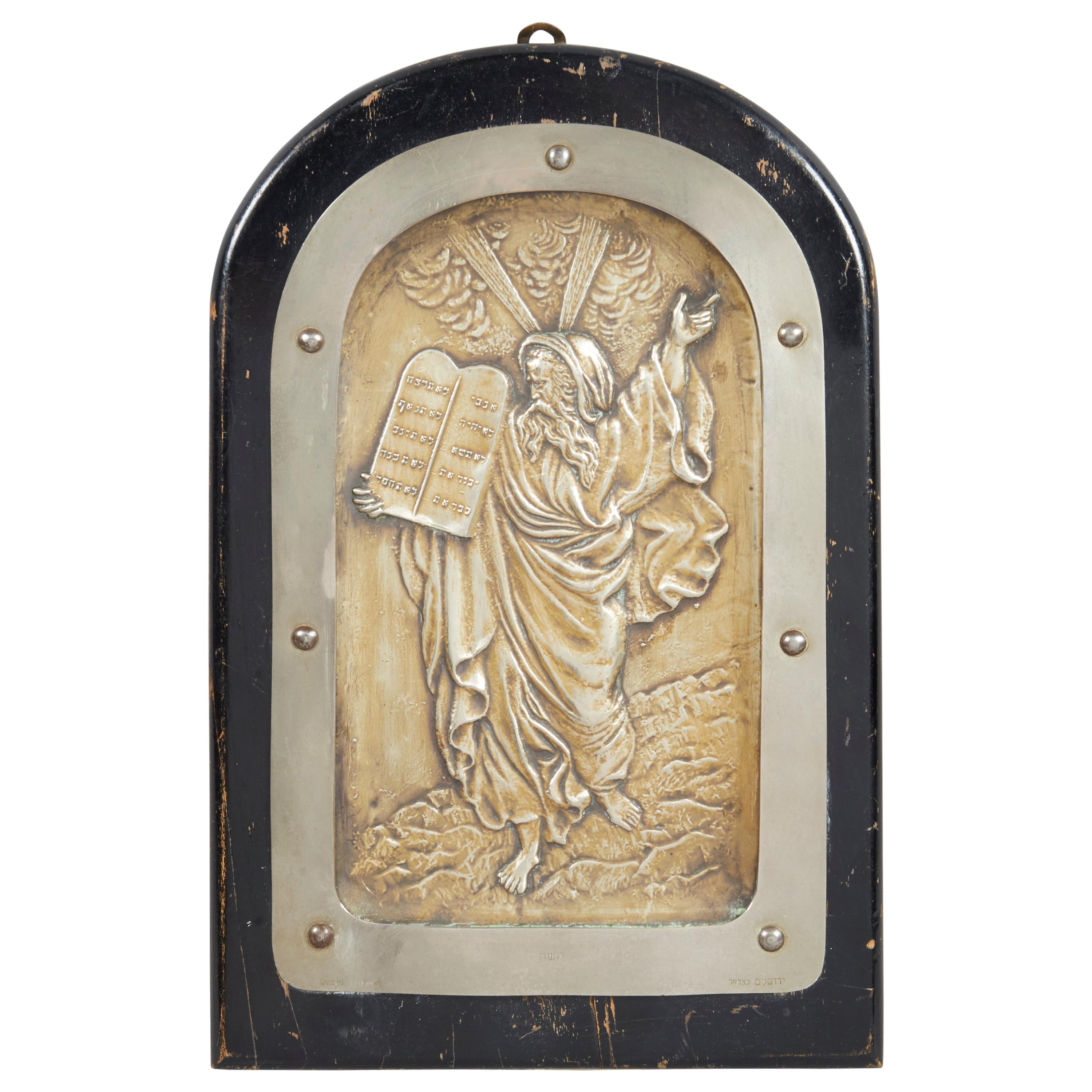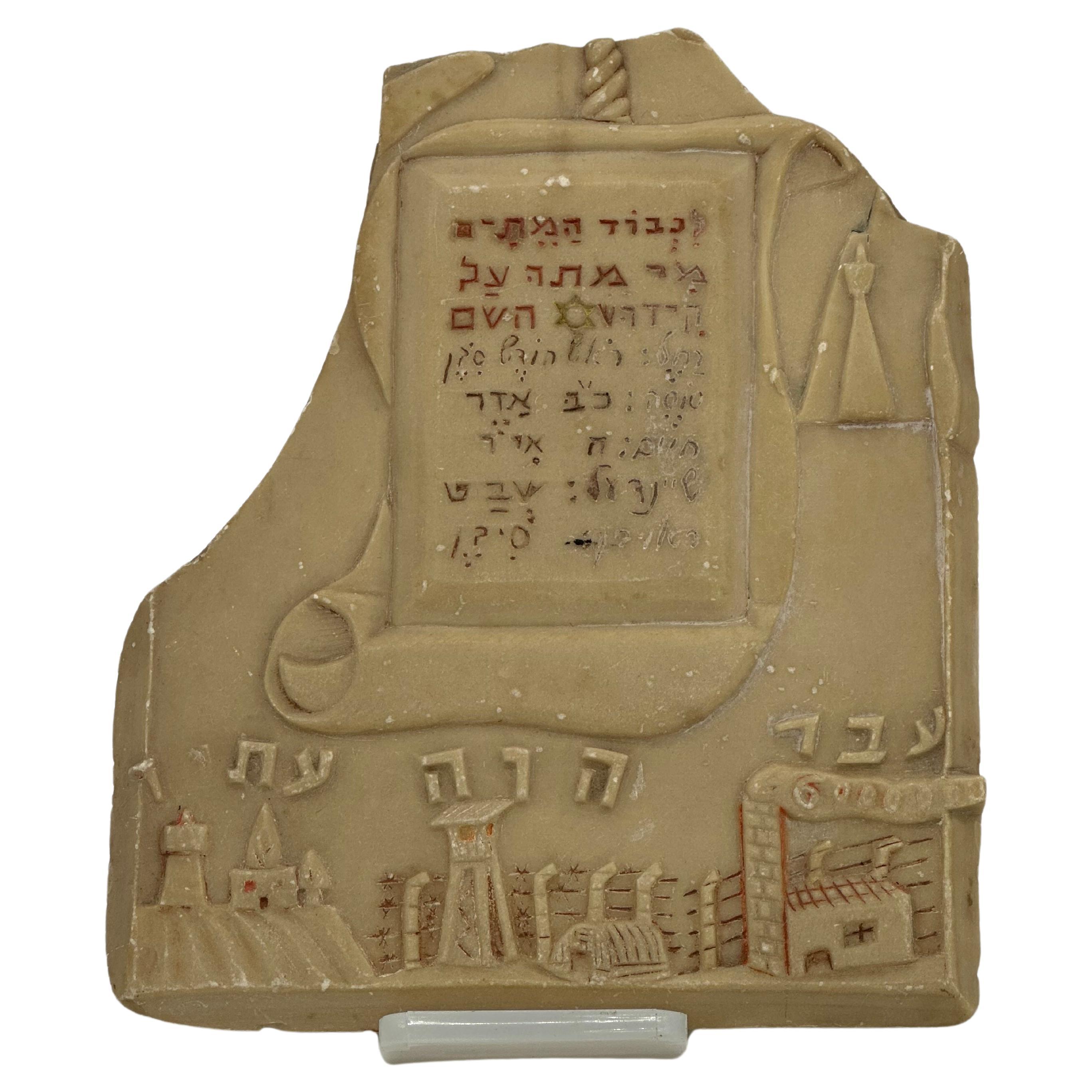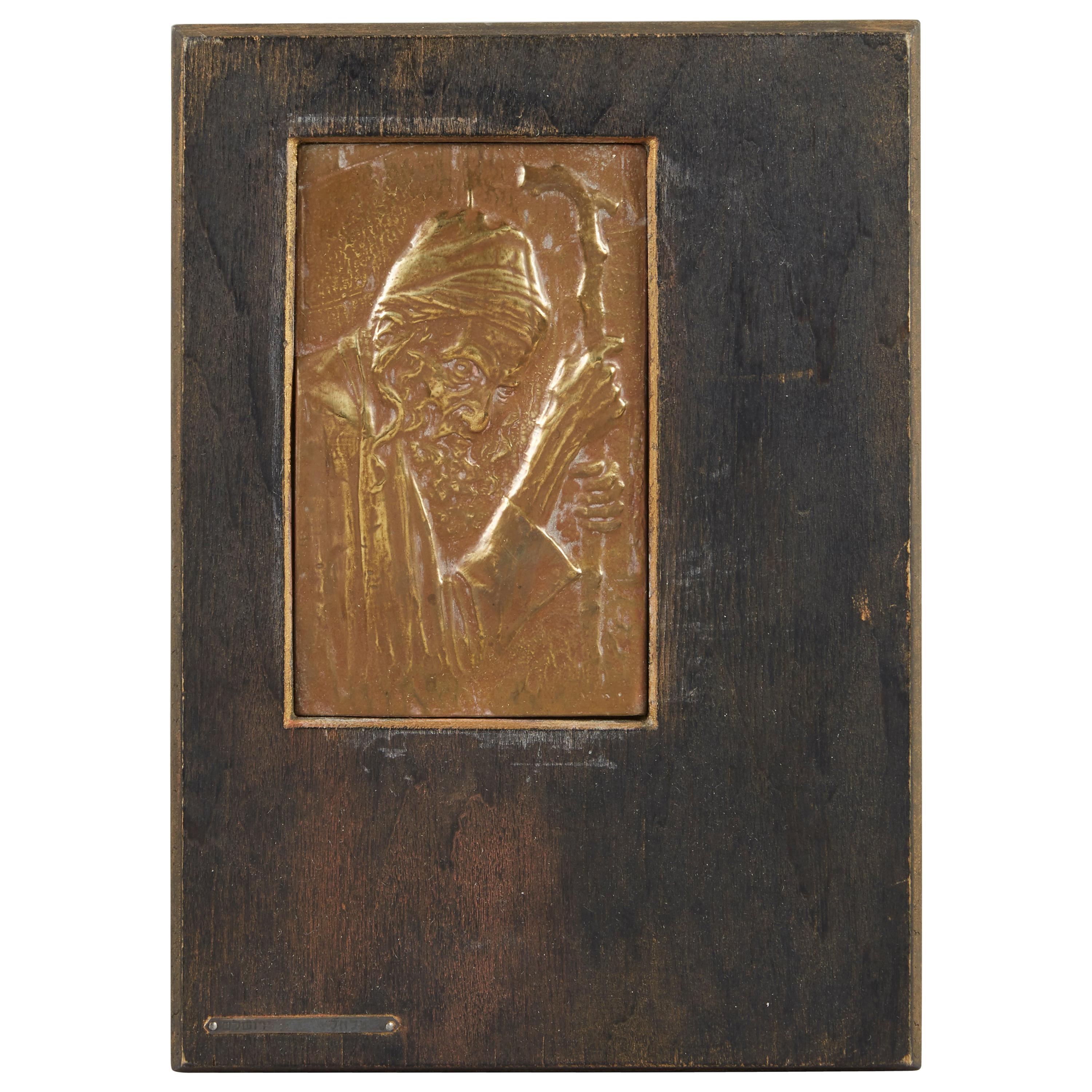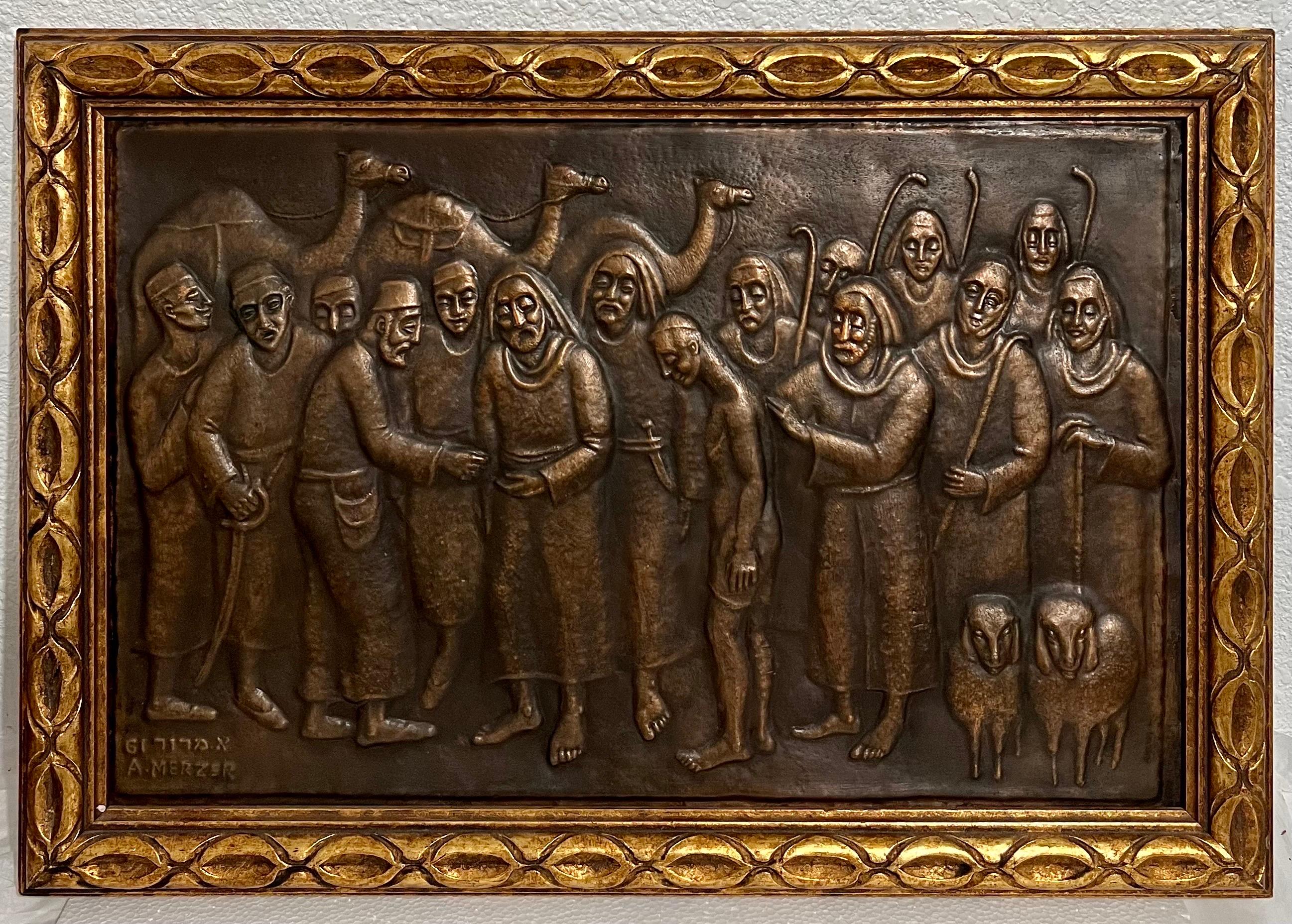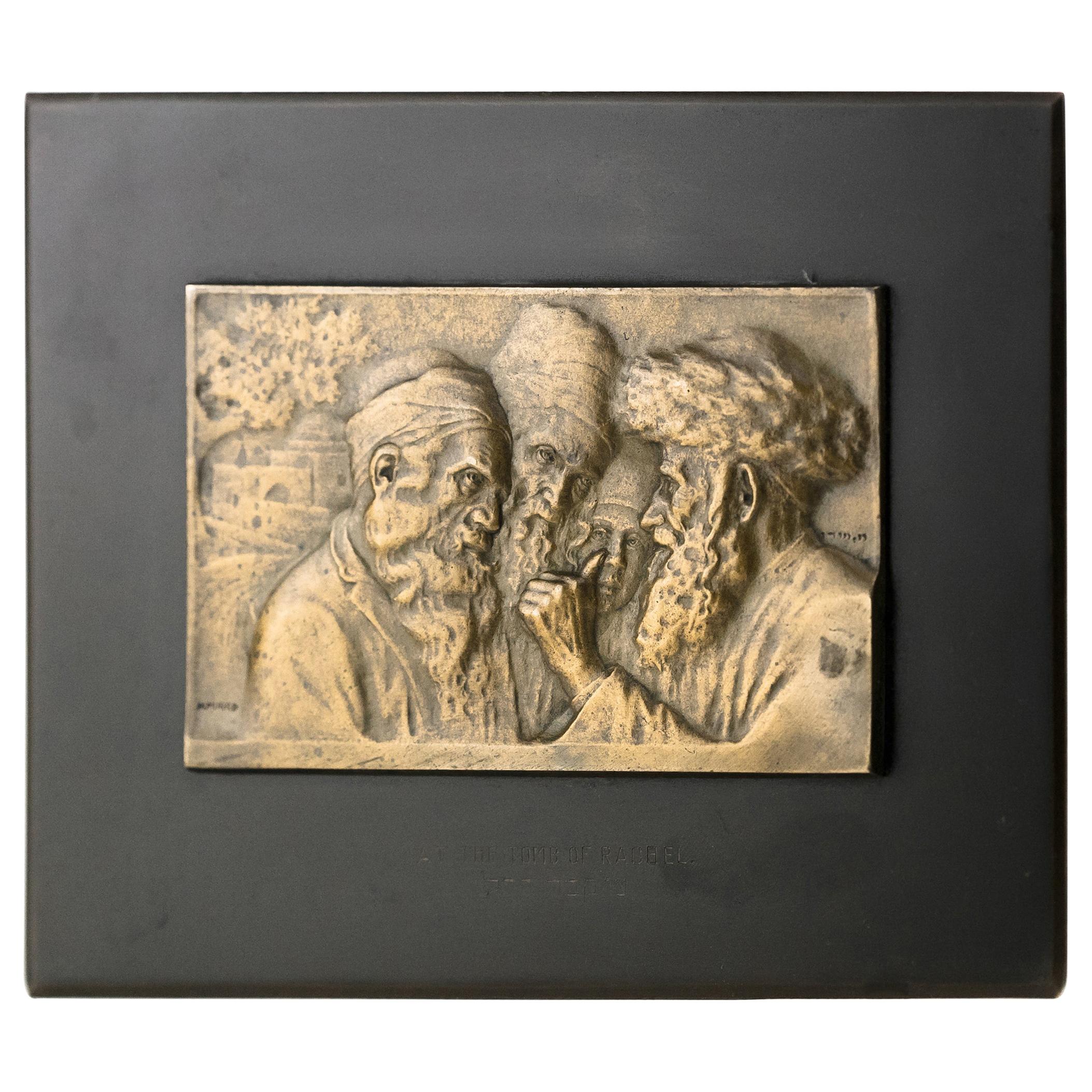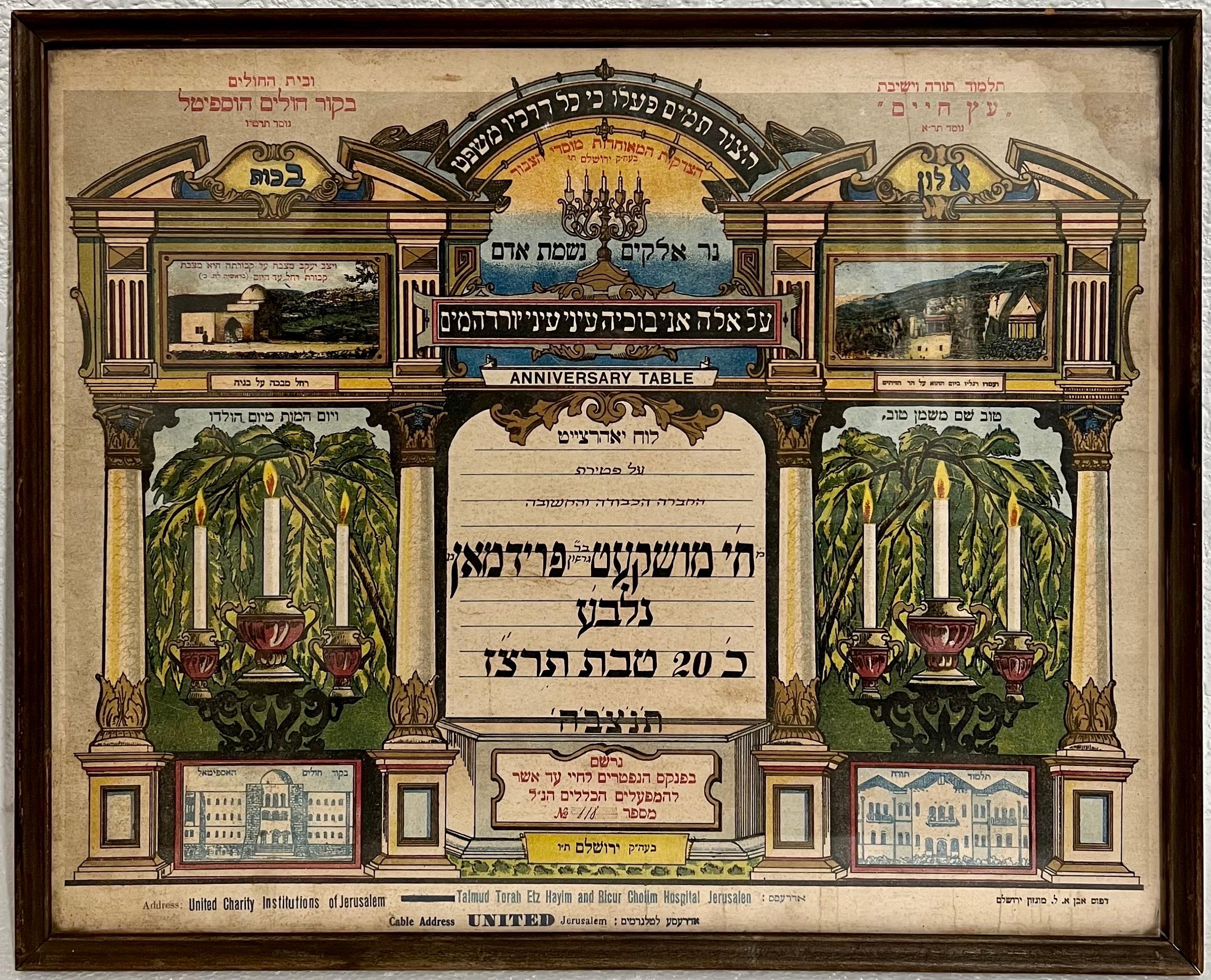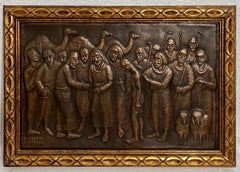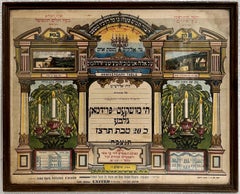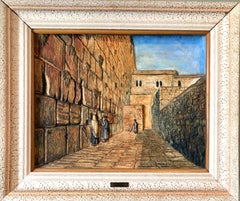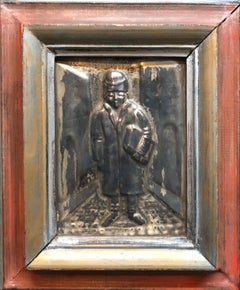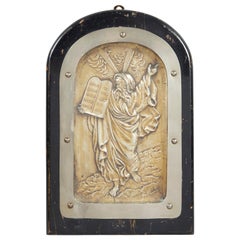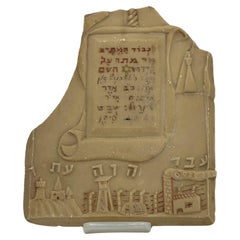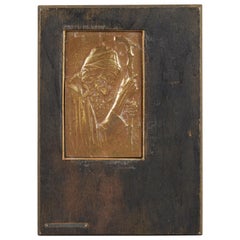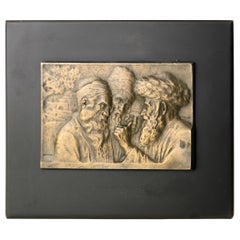Items Similar to Vintage Jerusalem Sculpture Wall Plaque 1930's Palestine Israeli Bezalel School
Want more images or videos?
Request additional images or videos from the seller
1 of 11
UnknownVintage Jerusalem Sculpture Wall Plaque 1930's Palestine Israeli Bezalel Schoolc.1930's
c.1930's
$1,250
£939.03
€1,082.86
CA$1,734.54
A$1,927.45
CHF 1,010.01
MX$23,636.79
NOK 12,882.05
SEK 12,118.96
DKK 8,082.01
Shipping
Retrieving quote...The 1stDibs Promise:
Authenticity Guarantee,
Money-Back Guarantee,
24-Hour Cancellation
About the Item
Repousse sculptural plaque from the original Bezalel Art School in Jerusalem.
This is marked "Made in Palestine" as it is from the British Mandate period. It is in an Orientalist design of the Tower of David. marked in Hebrew and English.
Jerusalem's Bezalel School
The Bezalel Academy of Arts and Design, was founded in 1906 by Boris Schatz. In 1903, Schatz met Theodore Herzl and became an ardent Zionist. At the Zionist Congress of 1905, he proposed the idea of an art school in the Yishuv (early Jewish settlements), and in 1906 he moved to Israel and founded the Bezalel School of Art in Jerusalem. Bezalel, which was a school for crafts as well as for graphic art, became successful very rapidly. Schatz’s vision was to develop useful arts and crafts among Palestinian Jews, thereby decreasing the dependence on charity. At the same time, he sought to inspire his students to create a Jewish national style of the arts, in order to promote the Zionist endeavor. The inhabitants of 19th-century Palestine, both Jewish and non-Jewish, had produced mostly folk art, ritual objects and olive-wood and shell-work souvenirs, as well as oil painting, sculpture, tapestry and mosaics. So the founding of Bezalel provided a professional and ideological framework for the arts and crafts in Jerusalem. The school employed workers and students, of whom there were 450 in 1913, in manufacturing, chiefly for export, decorative articles ranging from cane furniture, inlaid frames and ivory and wood carvings, to damascene and silver filigree and repousse work.
A major part of Schatz’s school was the workshops, which, starting with rug-making and silversmithing, eventually offered 30 different crafts. Workshops included the "Menorah" workshop where they designed relief and souvenirs made of terra-Cotta, and the Sharar, Stanetsky and Alfred Salzmann workshops where Menorah lamps, candlesticks, brass plates for Passover, and many other ceremonial and souvenir items were made.
Intended to create an original national style, Bezalel artifacts were a
mixture of oriental styles and techniques with Art Nouveau features, art deco styles and influences from the Arts and Crafts Movement.
The Academy reopened after Schatz's death in 1935 led by the new director, Joseph Budko, who took advantage of the many new European immigrants' talent and energy and succeeded in revitalizing the school. In the mid 1930's, Bezalel was reestablished by German and European refugee artists driven to Palestine by the Nazis, and underwent a final reorganization in 1965 that established Bezalel as a school for crafts. A small museum was added to the school which became the foundation for the Bezalel Museum later to become the world famous Israel Museum. Bezalel strove to foster in its students a national style of art, drawing both from European
techniques and Near Eastern art forms. While centers of Jewish art could be found elsewhere early in the 20th century (such as the school of Yehuda Pen in Vitebsk where Marc Chagall had studied) these were even more short lived. Bezalel subjects were a combination of traditional Jewish religious images, Zionist symbols, Biblical themes, views of the Holy Land and depictions of the flora and fauna of Palestine.
Artists at the Bezalel School used holy places, female figures and the beautiful landscapes of the holy land in their work.
Zev Raban, a major Bezalel artist, also designed products for various artistic cooperatives that were under the control of Bezalel: for Moshe Murro, Bezalel amulet artist, Raban designed many items, later executed in metal and ivory. For the famous Bezalel Yemenite jeweler- Yichieh Yemini, Raban designed many jewelries and Filigree works. Renowned Bezalel School artists include Meir Gur Arieh, Zev Raban, Jacob Eisenberg, Jacob Steinhardt, and Hermann Struck.
- Creation Year:c.1930's
- Dimensions:Height: 6 in (15.24 cm)Width: 11.5 in (29.21 cm)Depth: 1 in (2.54 cm)
- Medium:
- Movement & Style:
- Period:
- Condition:Measurements include frame.
- Gallery Location:Surfside, FL
- Reference Number:1stDibs: LU38216626142
About the Seller
4.9
Platinum Seller
Premium sellers with a 4.7+ rating and 24-hour response times
Established in 1995
1stDibs seller since 2014
1,782 sales on 1stDibs
Typical response time: <1 hour
- ShippingRetrieving quote...Shipping from: Surfside, FL
- Return Policy
Authenticity Guarantee
In the unlikely event there’s an issue with an item’s authenticity, contact us within 1 year for a full refund. DetailsMoney-Back Guarantee
If your item is not as described, is damaged in transit, or does not arrive, contact us within 7 days for a full refund. Details24-Hour Cancellation
You have a 24-hour grace period in which to reconsider your purchase, with no questions asked.Vetted Professional Sellers
Our world-class sellers must adhere to strict standards for service and quality, maintaining the integrity of our listings.Price-Match Guarantee
If you find that a seller listed the same item for a lower price elsewhere, we’ll match it.Trusted Global Delivery
Our best-in-class carrier network provides specialized shipping options worldwide, including custom delivery.More From This Seller
View AllLarge Judaica Copper Repousse Sculpture Relief Plaque Arie Merzer Bezalel Era
By Arieh Merzer
Located in Surfside, FL
Arieh Merzer (Israeli, 1905-1966)
Copper relief sculpture panel in gilt frame
Framed dimensions 18 X 26.25, copper 14.5 X 22.5
Arieh Merzer ...
Category
Mid-20th Century Figurative Sculptures
Materials
Metal, Copper
Rare Palestine Antique Hebrew Judaica Yahrzeit Synagogue Sign Memorial Plaque
Located in Surfside, FL
Circa 1890-1920. This Neoclassical, Judaic, Egyptian revival, Orientalist Mizrach sign, was produced in British Mandate Palestine by the chromolithograph process at the beginning of the 20th century. It pictures vignettes of holy places. with a hand written memorial. It was for the Tzedakah charity fund for the century-old institutions in Jerusalem: The great "Torah Center Etz Chaim"; a Free Kitchen for poor children and orphans; the famous Bikur Cholim Hospital with its dispensaries and clinics and the only Home for Incurable Invalids in Eretz Israel. They also worked with Arthur Szyk and Alfred Salzmann.. The A.L. Monsohn Lithographic Press (Monzon Press, Monson Press, דפוס אבן א"ל מאנזאהן, דפוס מונזון) was established in Jerusalem in 1892 by Abraham-Leib (or Avrom-Leyb) Monsohn II (Jerusalem, c.1871-1930) and his brother Moshe-Mordechai (Meyshe-Mordkhe). Sponsored by members of the Hamburger family, the brothers had been sent to Frankfurt, Germany in 1890 to study lithography. Upon returning to Jerusalem in 1892 with a hand press, they established the A.L. Monsohn Lithographic Press in the Old City of Jerusalem. According to the Information Center for Israeli Art A.L. Monsohn "created complex decorations for documents and oriental calendars that combined the tradition of Jewish art with modern printing techniques such as photographic lithography, raised printing and gilding."
The founders of the Monsohn press produced Jewish-themed color postcards, greeting cards, Jewish National Fund stamps, and maps documenting the evolution of the Jewish settlement in Eretz Israel in the nineteenth-twentieth centuries; religious material such as decorative plaques for synagogues, portraits of Old Yishuv rabbis such as Shmuel Salant, Mizrah posters indicating the direction of prayer for synagogues, memorial posters, and posters for Sukkot booths; color frontispieces for books such as Pentateuch volumes and the early song collections of Abraham Zvi Idelsohn (e.g., Shire Zion, Jerusalem 1908); artistic wedding invitations; and labels, packaging and advertisements for the pioneering entrepreneurs of Eretz Israel. The texts appearing in the Monsohn products were in several languages: Hebrew, Arabic, Yiddish, English, German (e.g., a c1920 trilingual Hebrew-English-Arabic "Malaria Danger" broadside warning the public of mosquitoes spreading malaria). Many of the brilliantly colored postcards and maps can be seen online as can the artistic invitations to his children's weddings which Monsohn published in the Jerusalem Hebrew press.
For years, the Monsohn (later, Monson/Monzon) Press was considered the best and most innovative in the country—pioneering in such techniques as gold-embossing and offset printing, among others. Early items for tourists included collections of Flowers of the Holy Land (c. 1910–1918)—pressed local flowers accompanied by scenes from the Eretz Israel countryside and relevant verses from the Bible, edited by Jsac Chagise (or Itzhak Haggis), an immigrant from Vitebsk, and bound in carved olive wood boards. Shortly after World War I Monsohn (now spelled מונזון) used zincography to produce the prints included in the Hebrew Gannenu educational booklets for young children illustrated by Ze'ev Raban of the Bezalel Academy of Art and Design and printed in Jerusalem by Hayim Refael Hakohen (vol. 1, 1919; vols. 2–3, 1920). In 1934 Monsohn moved into the new, western part of Jerusalem, in a shop with four presses and 30 workers, including Abraham-Leib's sons, David, Yosef, Moshe and Shimon, and his daughter Raytse's husband, Abraham Barmacz. The concern did business with all sectors of the city's population, including Arabs, for whom they printed in Arabic. Among their clients were members of the Ginio, Havilio, and Elite families, and Shemen, Dubek, and other renowned national brands, manufacturing products such as wine, candies, oil, and cigarettes. They also printed movie and travel posters, and government posters, postcards and documents, hotel luggage labels...
Category
Early 20th Century Aesthetic Movement More Art
Materials
Lithograph
Vintage Jerusalem Western Wall Relief Sculpture Model Diorama Painting Judaica
By Manobla
Located in Surfside, FL
Joseph Manobla, (Israeli, 1930-1979), The Western Wall (The Wailing Wall), Painted diorama sculptural relief, 12.5 x 15.75 inches (relief), 17 x 20.25 inches (including original painted artist’s frame), Signed lower right. titled verso "the Wailing Wall".
I am not sure of the material used. I have seen some described as jerusalem stone and some as composition.
Provenance: The Engel Gallery Jerusalem. The Engel Gallery was founded in Jerusalem in 1955. Rafi Lavi, Arieh Aroch, Aviva Uri...
Category
20th Century Modern Figurative Sculptures
Materials
Mixed Media
Judaica Silvered Copper Repousse Sculpture Relief Plaque Shtetl Yeshiva Bochur
By Arieh Merzer
Located in Surfside, FL
Arieh Merzer was a prominent Israeli artist and metal worker.
Arie Merzer, an artist who worked in hand-hammered copper, was born in Warsaw, Poland in 1905, the scion of a large Has...
Category
Mid-20th Century Figurative Sculptures
Materials
Metal
Judaica Copper Plaque Israeli Artist Mordechai Avniel, Palestine, Bezalel School
By Mordechai Avniel
Located in Surfside, FL
MORDECHAI AVNIEL
Minsk, Belarus, b. 1900, d. 1989
Mordechai Avniel is best known for his deft and singular landscape work.
He said of his scenes of Israel:
"I loved the Israeli landscape. While roaming the country extensively, I gradually absorbed its atmosphere, its lights and moods, the view of mountains and valleys, the Sea of Galilee...
Category
20th Century Modern More Art
Materials
Copper
Mod 1970's Israeli Judaica Folk Art Jerusalem View Enamel on Copper Painting
Located in Surfside, FL
This is a masterfully executed wall hanging enamel on copper painting of Jerusalem. it is signed in Hebrew. Israel has had a Vibrant Folk Art, Naive art scene for a long time now artists like Yisrael Paldi, Nahum Guttman, Reuven Rubin had naive periods. The most well know of the strict naive artists are Shalom of Safed, Irene Awret...
Category
20th Century Folk Art Landscape Paintings
Materials
Copper, Enamel
You May Also Like
Early 20th Century Silver Plate Plaque by Bezalel School Jerusalem
Located in New York, NY
Bezalel silver plate plaque depicting Moses at Mount Sinai, made in Jerusalem, circa 1925, marked "Bezalel Jerushalem" in Hebrew and "Made in Palestine,...
Category
Early 20th Century Israeli Decorative Art
Materials
Silver Plate
$720 Sale Price
20% Off
Historic Rare Carved memorial plaque made by Jewish internee in Cyprus, 1948
Located in Tel Aviv - Jaffa, IL
super rare and historic example of Cyprus stone carving, made by jewish holocaust surviver that was Detained at the Internment camps in Cyprus, just 3 years after the holocaust. this piece is very unusual, most of this carvings shows us aspects of living in the Refugee camps or zionist views of israel, sometimes they even made judaica objects like menorahs Or Candlesticks, but its rare to find memorial plaques such as the example in front of us, the plaques was Damaged In the way to israel and two pieces from the upper section were broken off, the middle part of the Plaque shows a Scroll shaped memorial plaque with the inscription : "for the dead who died on the name of god" In red color, the middle has a yellow star carved and painted, just like the yellow star jewish...
Category
Vintage 1940s Cypriot Antiquities
Materials
Soapstone
Early 20th Century Brass Plaque by Bezalel School Jerusalem
Located in New York, NY
Bezalel brass plaque depicting a Jewish elder next to the Western Wall, made in Jerusalem, circa 1920, bearing a small metal label engraved "Bezalel Jeru...
Category
Early 20th Century Israeli Decorative Art
Materials
Brass
$960 Sale Price
20% Off
Jews at Rachel's Tomb-Early 20th Century Bronze Plaque by Moshe Murro, Jerusalem
Located in New York, NY
Bronze plaque with a relife of the figures of three elderly Jews and young Jew with Rachel's Tomb in the background.
Made in Bezalel school, Jerusalem by Moshe Murro, circa 1915.
Si...
Category
Early 20th Century Israeli Decorative Art
Materials
Bronze
$1,940 Sale Price
20% Off
Early 20th Century "Netilat Lulav" Bronze Plaque by Boris Schatz, Bezalel
Located in New York, NY
Massive bronze plaque depicting the act of "Netilat Lulav" that takes place during the Jewish holiday of Sukkot. The plaque was made and signed by Boris Schatz, who was part of the B...
Category
Early 20th Century Israeli Neoclassical Wall-mounted Sculptures
Materials
Bronze
$6,800 Sale Price
20% Off
Vintage Hand Painted Ceramic Wall Hanging Tile by Israeli Artist
Located in Delray Beach, FL
Beautiful hand painted and glazed ceramic tile with people faces, Hebrew inscription ,in the style of cubist, or geometric. Signed by the artist.
The tile is professionally mounted ...
Category
20th Century Israeli Wall-mounted Sculptures
Materials
Ceramic, Wood
$400 Sale Price
38% Off
More Ways To Browse
Layla Luna
Leah Giberson
Leon Golub On Sale
Leonard Lopp
Leslie Molina
Lionel Treboit
Longhorn Steer Skull
Louisa Longstaff Scales
Lucie Cousturier
Malleus Maleficarum
Marc Chagall The Syrinx Fable
Marcel Favreau
Marcia Priestley
Marco Di Nieri On Sale
Marie Louise Ekman
Marina Del Pozo
Marius Borgeaud
Mary Rose Palau
